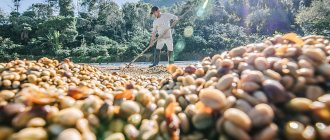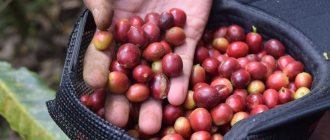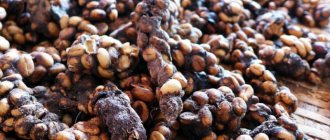People have different tastes, especially when it comes to coffee. Some people prefer the strong taste and bright aroma of African varieties, some appreciate the softness and delicacy of Colombian grains, and others are ready to defend the fiery delights of Cuban grain to the whole world. But most drink connoisseurs cannot resist the temptation of Costa Rican coffee. This Central American country has been supplying many countries around the world with high-quality grain for many years. You can find it in mixtures and blends or find it as a single variety. What is special about Costa Rican coffee and why do customers value it so much?
Characteristics of Costa Rican coffee
Coffee grown in Costa Rica is rightfully considered the best among the best in the world. Products from the Tarrazu region are especially valued, where about 35% of the country's total coffee production is produced. The Starbucks chain buys it.
According to the description of knowledgeable experts, the aroma and taste of the future drink depend on the region of cultivation of Costa Rica coffee and the further processing method:
- the “wet” method of grain processing makes it possible to obtain a softer drink (with the presence of honey, fruity flavor, diluted with a “note” of milk chocolate);
- “dry” processing gives the drink a citrus taste, with a berry “note”;
- honey processing removes the sourness from the finished coffee, imparting additional sweetness with a “note” of molasses.
Every year the republic hosts the “Cup of Excellence” – a coffee competition. The most popular Costa Rica coffee brands according to gourmet reviews: Doka Estate, La Minta, others.
Costa Rica grows high-caffeine Arabica beans. After all, this is the only place in the world where climatic and geographical conditions allow the production of this variety, subject to all appropriate requirements.
The unique taste of the famous Costa Rican coffee is due to its genetic purity. Arabica from Costa Rica is the best coffee, which has deservedly conquered the most sophisticated gourmets around the world.
Famous varieties
From us you can buy coffee from Costa Rica in Moscow of the most popular brands. The most famous names are on everyone's lips - but how do they differ?
Names are usually given according to the area where the trees grow.
"Tarratsu"
- high mountain region, fields are located at an altitude of 1,200 to 1,700 meters. From there, a strong, dense, rich drink with a chocolate aftertaste and a sour fruit and berry aftertaste with spicy notes.
"La Minita"
- from the same area. The production has been owned by the same family for three generations. Selected product with a rich multi-component taste.
"Tres Rios"
- famous beans with a bluish tint, giving sweetness with a bright fruity bouquet.
"Brunka"
- tart and sour, with a rich fruity-citrus aftertaste.
Costa Rican coffee classes
- SHB or Grown Mountain is the best product category;
- GHB – fairly good quality;
- HB or Hard Bean Medium (MHB) has good quality indicators based on the height of the growing plantations (900-1200m);
- LGA – labeling of Costa Rica lowland coffee.
The product class directly affects the formation of its cost. The average price of roasted grain (per 1 kg) is 1800 rubles.
Arabica from the Tarrazu region is considered the best in the world. The following varieties are known:
- Marcos;
- Sarchi;
- La Minita Tarrazu is hand-sorted;
- Britt is sorted and cleaned by hand and has a low caffeine content.
The secret of quality
Coffee plantations throughout the country are located on the slopes of volcanic mountains or in their valleys. Interestingly, the taste and aroma characteristics of Arabica beans are affected by the altitude at which the plantation is located: the higher above sea level, the higher the quality of the coffee.
The country has its own classification of Arabica varieties:
- SHB (Strictly Hard Bean) is coffee collected from the highest mountain plantations, located at an altitude of about 1500 meters above sea level. Even the most sophisticated gourmets dream of enjoying the taste of a drink made from precisely these grains, which are especially hard;
- GHB (Good Hard Bean) – the altitude of this coffee growing is from 1200 to 1500 m;
- HB (Hard Bean) or MHB (Medium Hard Bean) - grains obtained from plantations located in flat areas;
- LGA (Low Grown Atlantic) is the lowest grade of lowland coffee.
In addition, there is a classification of grains by region of growth. The best Arabica coffee on the planet is considered to be from the Tarrazu region. Its most famous varieties with a unique taste and aroma are:
- Sarchi - grown on the volcanic slopes of Poas;
- Marcos is famous for its deep, unique taste with a slight sourness;
- Britt – cleaned and sorted only by hand. The finished drink is quite thick, with rich flavor and aromatic qualities, which is why the variety is so highly valued, despite the low caffeine content;
- La Minita Tarrazu is a hand-sorted product that produces an exquisite drink with a rich range of flavors.
Costa Rican coffee is also represented by such varieties as Tres Rios, Santa Rosa, Heredia - any of them has impeccable bean quality, a unique, rich, distinctive taste.
To further popularize and advertise the drink, farmers organize holidays and festivals, and the government of the country has laid out a special tourist route, “The Coffee Road.” It includes several main plantations. The country also holds an annual National Coffee Day with the support of the Ministry of Agriculture.
Costa Rican coffee
Just like live coffee from Brazil, varieties from Costa Rica can be brewed in many ways:
- Using any filter (through which hot water passes).
- In a capsule coffee maker.
- In this case, you will need a French press.
- A great way is in an espresso machine.
- Pour boiling water over the ground grains and let the drink steep under the lid (an affordable option for home preparation in the absence of specialized equipment).
The degree of roasting may vary. It is difficult to spoil Costa Rican coffee using any of the brewing methods presented.
The traditional recipe for making a drink in Costa Rican does not involve the use of a Turk or other devices:
- coffee beans – 1 tsp;
- water – 100 g.
A filter is made from gauze and placed on the surface of the cup. Crushed grains are placed on it. I pour boiling water through this device. The drink in the cup is the national coffee of Costa Rica.
Growing regions
Population: 4,900,000
Number of bags (60 kg): 1,396,000
In the past, Costa Rica has successfully marketed its coffee under the names of the regions in which it was produced. However, coffee from any one region has a wide variety of flavors, so it's worth exploring each region to see what kind of coffee it offers.
Central Valley
This most populous region of Costa Rica is home to the country's capital, San Jose. Coffee was first grown here. The region consists of three provinces - San José, Heredia and Alajuela. The three volcanoes located here - Irazu, Barva and Poas - influence the topography and soil. Altitude: 900-1600 m Harvest: November - March
West Valley
The first farmers settled in the Western Valley in the 19th century and brought coffee beans with them. The region consists of six cantons with the centers of San Ramon, Palmares, Naranjo, Grecia, Sarchie and Atenas. The town of Sarchie gave its name to a coffee variety called Villa Sarchie. The highest altitude coffee is grown in the Naranjo region and some amazing beans can be found there. Altitude: 700-1600 m Harvest: October - February
History of Costa Rican coffee
Arabica beans first appeared in Meseta Central, a region of the Costa Rican state, back in 1779. Gradually, with the support of the government (farmers received loans for business development), coffee production in Costa Rica increased. The ideal natural conditions of this republic played an important role in increasing the volume of production.
At the beginning of the 19th century. On the territory of Costa Rica there were entire systems of coffee plantations. And just 30 years later, this product became the main source of income for the country, relegating cocoa, sugar and tobacco to the background.
During this period, Costa Rica, following the example of other Spanish colonies, declared its own independence. And in the 30s of the XIX century. established the export of coffee beans to Chile and Great Britain. By the way, the United Kingdom was the main buyer of Costa Rican coffee until World War II. The Kingdom, interested in constant supplies of quality goods, has invested heavily in the development of the Costa Rican coffee industry.
The country's profits covered more than just improvements in agricultural technology. It was enough for the development of other areas: the construction of the railway, the construction of the National Theater in the capital, and the transfer of many other areas of life in Costa Rica to a higher quality level. This has helped coffee farmers become the most respected members of society.
In the middle of the 20th century. A customs duty was introduced on coffee. In 1983, numerous plantations were attacked by a pathogenic fungus, destroying future harvests. This disaster led to a crisis in coffee production that lasted about 7 years.
What is different about the Costa Rica Tarrazu variety?
This variety is grown in the Torrazu region of the same name. The peculiarity of this coffee is that the grain is flat in shape and has a bluish tint. The peculiarities of the climate and geographical location give this variety amazing taste properties. The harvest here is harvested in November - March; during this season, the grains are the most ripe and of the highest quality, and they can also be immediately dried in the sun.
Coffee of this variety has an excellent rich taste, striking in its lightness and purity. The excellent structure of the finished drink is a great reason to buy a coffee stick . Its interesting feature is that it preserves all the nuances of taste even when chilled. For this quality it is especially appreciated in the process of preparing cold coffee drinks.
In its pure form, this coffee amazes with the richness of its intense taste, reminiscent of Burgundy wine. The aroma is pronounced with a long finish containing notes of dark chocolate, candied fruits, bread and hazelnuts, and is surprisingly full of richness.
14.04.2016
Interesting facts about Costa Rican coffee
- The Republic of Costa Rica has the highest coffee production in the world - 1,600 kg per hectare (56,438 ounces).
- 80 thousand farms of various levels are involved in the state's coffee industry.
- Most types of Costa Rica coffee are certified as “bird-friendly” - a high degree of environmental safety of the product for the environment (the planet’s ecosystem is not disturbed, since birds can nest on the trees around the plantations).
- Coffee from Costa Rica is of the highest quality, the highest quality product in Central America.
Production
Under the current reality, the volume of coffee grown in Costa Rica is directly dependent on low-paid seasonal labor. Farmers everywhere hire cheap labor from economically undeveloped countries. In this way, they simultaneously save their own money and provide work to the unemployed population.
Today, coffee beans are processed in the following ways:
- The skins are removed from the still fresh fruit and its pulp is removed - the “wet” method;
- dried grains are cleaned by removing the pulp - the natural or “dry” method;
- the skin is removed from the still fresh fruit, and the pulp is removed after drying the beans in the sun - the honey or “semi-dry” method (the coffee acquires a special aroma and natural sweetness).
The republic is home to the IWCA, a representative office of the international alliance. Its activities are aimed at supporting the female population who are employed in the coffee industry.
The organization defends their rights, including equal pay to men. The main principle of the alliance is to credit the woman’s account with the earnings of the entire family, a farmer employed in the coffee growing industry.
Coffee secrets of Costa Rica
Coffee beans on Costa Rican farmlands ripen at a temperature comfortable for the fruit tree – 17-23 °C. This is possible due to the location of coffee plants in the shade of fruit plantings. This way the coffee matures faster and is of better quality. Its taste characteristics improve and the caffeine content increases.
The coffee business in Costa Rica is established under strict adherence to the rules and regulations characteristic of quality production. Its activities are regulated by Producer Associations, as well as the National Coffee Institute. Everyone benefits from this: farmers, consumers, production workers and the state.
Advertising of Costa Rican coffee in international markets has been established. In Costa Rica, thematic and presentation coffee festivals are held at a high level. Tourists can take part in specially organized trips along routes laid out in the regions where the national wealth of the republic is grown.
Production Features
The coffee business in the country has been successful due to favorable climatic conditions, but local residents have also made a significant contribution. They take their work with great responsibility and strive to introduce new technologies. Even despite the decrease in the area of coffee plantations in Costa Rica, record harvests are being harvested here. Each hectare yields up to 1,700 kg of grains.
In the description of the technology for growing fruits, several points are highlighted that have brought success to the coffee industry in the country:
- control over the genetic purity of Arabica;
- favorable climate - cool nights, frequent rains;
- ongoing government support for manufacturers;
- strict control over product quality;
- use of honey method of drying raw materials;
- The grains are selected using electron chromatography, which makes it possible to reject those that do not meet the standard.
Regions of production
| Region | Altitude (meters above sea level) | Harvest | Characteristics |
| Brunca | 800-1200 | August—January | Average acidity values of the body of the fruit aroma |
| Turrialba | 600-900 | July—December | Average acidity of the fruit body Strong aroma |
| Orosí | 900-1200 | September—February | Medium to high acidity Good fruit body Strong aroma |
| Tres Rios and Cartago | 1200—1650 | December—March | High acidity Good fruit body Strong aroma |
| Tarrazu | 1200—1700 | December—March | High acidity Good fruit body Strong aroma |
| West Valley | 1200—1650 | November—March | High acidity Good fruit body Strong aroma |
Read: Italian coffee: varieties, varieties and methods of preparation and Varieties of Brazilian coffee, types










